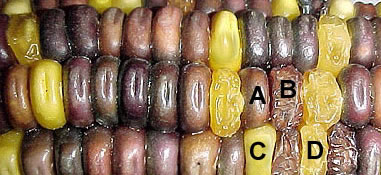AP Biology Genetics Lab
Download spreadsheet | Online Spreadsheet | Chi Square Test | photos of corn
Description: The purple color is produced by a pigmented layer within the grains. If the layer is not pigmented (colorless), the yellow color of an inner tissue shows through. Sweet corn grains wrinkle upon drying while starchy grains remain smooth. Individual kernels may be (A) purple—starchy, (B) purple—sweet, (C) yellow—starchy, or (D) yellow—sweet. Because these traits are easy to see, a monohybrid or dihybrid cross provides a very easy way to see if these traits are inherited independently (Law of Independent Assortment, Mendelian), or are linked (Non-Mendelian). You will be given an ear of corn was produced by a dihybrid cross involving two pairs of heterozygous genes resulting in a theoretical (expected) ratio of 9:3:3:1.
If your probability value is .05 (5%) or less, then your ear of corn deviates significantly from the theoretical (expected) ratio of 9:3:3:1 for a dihybrid cross. A probability value of 5% or less is considered to be a poor fit. One possible reason for a poor fit is autosomal linkage, where more than one gene is linked to the same chromosome. Determine if tehese dihybrid crosses indicate autosomal linkage of traits.

